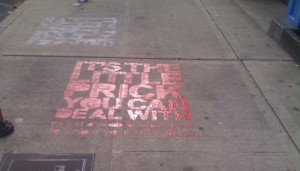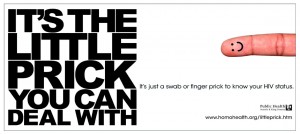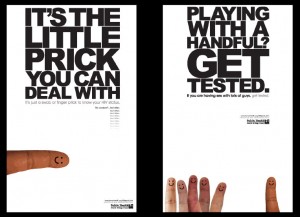Tuesday, January 31, 2012
Flying People
Flying People Article
I just got home, sat down, and did a double take as I saw this on the front page of Yahoo...the article talks a bit about how the video was done for Chronicle and also about Thinkmodo, a company that specializes in viral marketing. I was definitely curious about it after seeing it in class earlier so figured I'd post it up!
Absolute never stops
Absolute Vodka places itself as top innovator and an incredible branding statement. Absolute uses mainly print materials and carefully selecting magazines and newspapers to target. They keep themselves update and fresh and always current.
Absolute does a great job incorporating new material to their distinctive element: the bottle. They have been able to use similar messaging and elements worldwide and still keep relevant to local audiences.
Ferris Bueller's new CR-V
I loved this ad from the moment I saw it. My dad was the first one to send it to me.
I think the fact that it was a father writing to his daughter made it even more memorable and compelling. A mother wanting to show her child every little moment of the first parts of their life is expected and overdone. However a father writing sweet things to his toddler daughter is without question very rare in ads. It just adds one more element to an adorable ad.
Honey Badger Don't Care
I Have Thunder Thighs
Nike's "My Butt" advertisement campaign was run in a three part series capturing the attention of young female athletes in multiple sports. Nike seemed to leverage the young female trend of cutting magazine clips (Pintrest is the next generation of this trend) to pin up as inspirational artwork. The ad was beautifully designed with an elegant font type and reminded displayed on my walls throughout high school and college.
The artwork only complemented the inspirational messaging to create an extremely compelling advertisement. The ad captured the attention of female athletes everywhere whose training to be fit gave them a bodily shape different that the size two model, and honored her dedication to health and fitness. The ads began with a provocative introduction proclaiming "my butt is large" or "I have thunder thighs" and continued to honor the hard work and dedication of a young female athlete, myself included.
http://www.adwomen.org/2011/06/controversial-nikes-campaign-for-women/nike-women-i-have-thunder-thighs/
Carl's Jr. Ads
Coca Cola: the best and positive message ever!
Reimagining a Classic
If you couldn't tell, I'm talking about LEGO bricks.
The catalog of LEGO products is extensive and they've benefited from licenses with companies such as Lucasfilm, enabling the company to create engaging, life-like scenes. Even I recently completed a LEGO set, when I built my very own Space Needle replica.
However, Most of the ads I've seen for LEGO over the years have been formulaic: kids building and then playing with a variety of LEGO creations.I'm sure most of us have seen these if we've watched even 10 minutes of children's programming. I was pleased, then, when I saw a print campaign that drives at getting older kids (including me) to remember the fun that LEGO provides.
 | |
| The "Red Brick" ad for LEGO is just one in a series of four ads. |
Ultimately, a company like LEGO is all about creativity. LEGO can absolutely provide fun as they've shown in ads for years, but what sets them apart is the ability to turn a series of LEGO blocks into, well, anything. While I'd feel quite silly playing with my GI Joe or POGS, LEGO has reminded me that it makes more than toys - it makes whatever I want it to make.
Monday, January 30, 2012
New Article Connecting Facebook, Social Networks to our very beginnings
Hope everyone enjoys it!
http://cosmiclog.msnbc.msn.com/_news/2012/01/25/10234789-facebooks-roots-go-way-way-back
And here is a video they did in case you'd rather watch than read.
Save the Planet, Hug a Polar Bear
One such ad is the Polar Bear ad for the Nissan Leaf. This ad speaks directly to its target market with eloquence and heart. Nissan focuses the ad on a real issue that its market cares passionately about - the melting of the ice caps and struggle to save the polar bears. Once its audience is hooked it turns and connects the success of this struggle with driving a Nissan. Among the beautiful music and imagery, the ad resonates with viewers not only for it’s ability to tell a story, but also for it’s ability to show how our actions at home can effect the world, and sometime for the better.
It’s a wonderful ad that convinces you that by driving the Leaf you will save the polar bears, and who wouldn’t want to save the polar bears if they could?
where’s your mustache?
hay tu bo thuoc la vi suc khoe ban than gia dinh va cong dong
'Happy to help' - anytime, anywhere...
The Internet Moves Pretty Fast...Whether or Not You Look Around
Eventually, curiosity gets the best of me and I head to YouTube to check it out, not knowing what the ad was even about: http://www.youtube.com/watch?v=VhkDdayA4iA&NR
Matthew Broderick still kills it. I know it's nostalgic, and that it's pandering to the carefree(?) 80s aesthetic that I was too young to appreciate the first time around. The ad itself is largely predictable, but it's still full of nice touches, with the music from Yello going a long way to set the scene.
On repeated viewings, what I appreciate most about the ad (other than MB's spot-on vocal inflections) is how seamlessly the automobile being pitched is worked into the proceedings. "The car" was undoubtedly a key component of the original film, although the Ferrari and Honda CR-V are worlds apart. However, given that Matthew is all grown up with a family, it sort of makes sense that 2012 might find him in a different ride.
As for why I found it compelling, I like that they were able to reference and make use of the Ferris Bueller character without showing the world a middle-aged Ferris (the ad makes it quite clear that we're watching Matthew). Seeing the actor revisit one of his beloved characters gives everyone a nice feeling of familiarity without the uncomfortable idea that the iconic Ferris grew up just to hawk cars. Second, the final segment shows how much fun anyone (not just a famous celebrity/fictional character) can have in a CR-V, while also serving as a nice callback to the garage valet in the film.
In the modern era, we recognize that actors occasionally need to mix commerce-focused work in with the rest of their art. Cheers to Matthew and Honda for giving the people more of what they want without ruining something they love.
"Living Vicariously" Advertising
So when I tried to think of my favorite ad, nothing came to mind.
Instead, I thought about how the average kid sees around 300 advertising commercials a day. I thought about how my son often sounds like a ramped up (and more violent) version of Mermaid Madison in "Splash" after her day in front of a TV. I tried to think about where one could go nowadays where there isn't a TV or a radio or computer or people staring at their handhelds.
Yes, I am "adverTIRED."
But last Friday night after work, I was sitting in the PCC in Edmonds eating pizza from the deli. In front of me was the store's in house tabloid publication. It described the specials, yes, but also featured opportunities to take part in cooking classes, try novel recipes, and take my child to a special exhibition at the Burke Museum about growing organic foods.
And in a single moment, I forgot that I lived in suburban Shoreline and that the cloud cover for the last week or so had reached down to my ankles.
Did I sign up for the cooking classes or see the exhibit? No. Instead, it "felt" like I had done it ... experienced it. Suddently the pizza tasted better ... somehow more wholesome.
It's that kind of thing that keeps me coming back to the PCC ... that and the Tickled Pink scarves they sell.
Love Puppies and Kittens, Hate Sarah McLachlan
As the event was wrapping up I commented to one of my coworkers that I found it surprising that after more than 20 years working for the Humane Society in different capacities, their Development Director was remarkably unjaded and still seemed to feel genuine compassion for the thousands of animals that came through her facility each year. I casually asked her about the well-known BC SPCA television commercial featuring video clips of puppies and kittens set to a tear-jerking song by Sarah McLachlan. You know the one:
I originally found it very compelling (as did many other people) but after a couple views I couldn't stand to watch it any more. I, like many of the people I've casually asked, now mute the television or change the channel as soon as I see the ad come on because it's thoroughly depressing.
My question for you is: At what point should an organization like that change its message? Their ad was extremely powerful and drove people to action the first couple times they saw it, but now people actually avoid watching the ad. Do you think the SPCA is just going for the "one time sale" when it comes to donations? Or are the subscribing to the "no such thing as bad press" belief? I mean, that ad is 4 or 5 years old... but we're still talking about it.
Just A Little Prick
 |
| Sidewalk chalk outside pubs in Seattle's Capitol Hill |
Visually memorable
Absolut
I Want You to Want Me
Advertising: We put that S*** everywhere!
While the commercial itself was cute & clever what makes it a good ad in my mind is how well it stuck with all of us. To this day those of us that were in the car will randomly credit something to Frank's Red Hot, or randomly exclaim 'I put that S#*! on everything!'. And we always laugh. The beauty of the ad was not just the clever set up or punch line, it was the mutual experience it created. The interest, confusion & group belly laugh - it was a shared moment. Why I know it was a good ad? Now I can't pick up ANY hot sauce without thinking of the cussing granny.
http://cdn.hiphopnc.com/files/2011/03/franksredhot.jpg
Santa has Siri!
Hyundai Card
Dear Sophie
I know that this was shown in class, and most of us probably saw it even before that, however when I think of an ad that is compelling, it was the first and only one to come to my mind. I realize that they were intentionally shooting for the emotional angle but I still cried pretty heartily upon the first viewing and for a few viewings after that.
I think it’s compelling because it took a simple idea of a father and a daughter and the love that they share and because so many people can relate or at the very least understand it, the video appealed to such a broad range of consumers. If I take a step back, it’s actually pretty crazy to think that I would watch 90 seconds of a stranger’s home movies, and then cry afterward. Yet it’s what happened, and I think it’s a pretty incredible feat on Google’s part.
Moreover, I also think they did a great job at branding themselves as an emotional company that has to bring itself to life both in front of the computer and out in the world. I read an article that quoted Loraine Twohill (Google’s Vice President for Global Marketing) as saying, “It’s about emotion, which is bizarre for a tech company.” I do understand that it’s not a connection I would’ve made on my own but I think it’s worked out very well for them at least in my instance: just last weekend as I was searching Google for movie showtimes, I sighed to myself as I thought about this video and picked up my phone to give my dad a call just to say hello.









